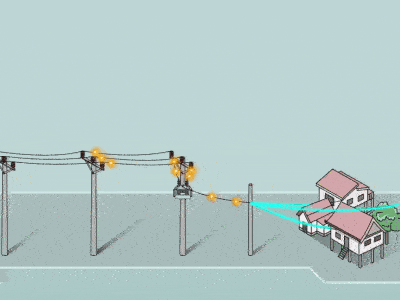
This animation shows how electricity is delivered from the local substation to homes, shops, and small industries.
The distribution system is the final stage of the power network, where high-voltage electricity is stepped down to safe levels and sent directly to consumers.
Key Components:
- High-Voltage Lines: Carry power from the main transmission network to the local area.
- Distribution Transformer (Step-Down): Reduces voltage from high (e.g., 11 kV) to low (230/400 V) for household and commercial use.
- Low-Voltage Distribution Lines: Carry electricity from the transformer to houses and nearby buildings.
- Service Drop: The final cable connection that enters each home and connects to the meter.
- Consumer Loads: Houses, shops, and small industries using the supplied electricity.
Working Principle:
- Electricity arrives from the transmission network at a higher voltage.
- A distribution transformer lowers the voltage to safe levels for end-users.
- Power flows along low-voltage lines toward streets and neighborhoods.
- From poles or underground cables, electricity is delivered via a service drop to each house.
- Homes receive 230 V (single-phase) or 400 V (three-phase) depending on the requirement.
The distribution system ensures that electricity is delivered safely, reliably, and at a usable voltage to all consumers.
⚡ Tip:
Distribution lines are equipped with fuses, insulators, and surge protectors to prevent faults and ensure safe delivery of power to homes.

